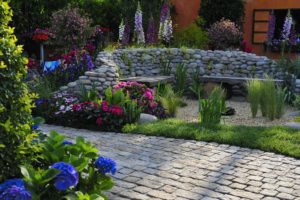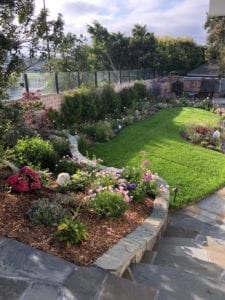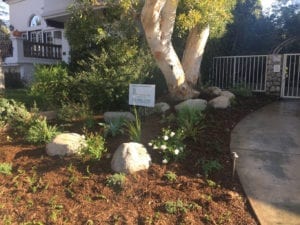Gardening is a fulfilling and rewarding hobby, allowing you to create beautiful outdoor spaces and grow your own food. However, with the increasing concerns over water scarcity and environmental sustainability, it is crucial to adopt water conservation practices in your own home garden. By implementing mindful water-saving techniques, you can help preserve this precious resource and contribute to a more sustainable future.
Below are 15 effective ways to conserve water in your garden, ensuring the vitality of your plants while minimizing water waste.
1. Mulching
Mulching helps retain soil moisture and prevent water runoff. It also regulates soil temperature and suppresses weed growth. Additionally, organic mulch enriches the soil as it decomposes. This process improves soil structure and fosters a healthy ecosystem for beneficial soil organisms. Mulching also reduces the frequency of watering, leading to water conservation and a more sustainable garden environment.
2. Drip Irrigation Systems
Drip irrigation delivers water directly to plant roots, reducing evaporation and weed growth. It can be automated and is adaptable to garden changes. With precise water delivery, drip irrigation minimizes water waste and ensures that plants receive just the right amount of water they need. This targeted approach promotes healthy plant growth while conserving water resources. Additionally, the controlled water delivery of drip irrigation minimizes soil erosion and nutrient leaching, contributing to a more sustainable gardening practice.
3. Rainwater Harvesting
Rainwater harvesting collects rainwater for garden use, reducing reliance on municipal water sources. It’s eco-friendly and can benefit sensitive plants. By utilizing rainwater, gardeners can contribute to water conservation efforts and reduce water bills. Additionally, the absence of chlorine and other chemicals commonly found in tap water makes harvested rainwater a healthier option for plants. Rainwater harvesting systems come in various sizes and designs, allowing gardeners to customize their systems based on garden size and water needs.
4. Soil Amendment
Soil amendment improves water retention and enhances soil structure and nutrient availability. It fosters beneficial microorganisms and reduces the need for frequent watering. By incorporating organic matter into the soil, gardeners can create a more hospitable environment for plant roots to access water and nutrients. The improved soil structure also promotes better aeration, leading to healthier root systems and improved plant growth. Soil amendment not only conserves water but also contributes to the overall health and fertility of the garden ecosystem.
5. Xeriscaping
Xeriscaping uses drought-tolerant plants and hardscape elements to create low-water gardens. It promotes sustainable landscaping and reduces maintenance costs. By selecting plants that are well-adapted to the local climate, gardeners can significantly reduce the water requirements of their landscapes. Additionally, incorporating hardscape elements like rocks and gravel helps conserve water by minimizing the area of the garden that requires irrigation. Xeriscaping encourages a more environmentally friendly approach to gardening and fosters a sustainable balance between water conservation and aesthetic appeal.

6. Grouping Plants by Water Needs
Grouping plants based on their water requirements ensures efficient water usage. It prevents overwatering or underwatering of specific plant varieties. This practice allows gardeners to tailor their watering schedules and methods to the specific needs of different plant groups. By grouping plants with similar water needs, gardeners can optimize water usage, leading to healthier plants and a more sustainable garden ecosystem. Properly organized plant groupings also contribute to a more visually appealing garden layout.
7. Watering Early or Late
Watering during cooler hours reduces water evaporation and ensures effective water absorption by plants. It also minimizes water loss due to evaporation. By watering early in the morning or late in the evening, gardeners can maximize the effectiveness of watering and minimize water waste. This practice is especially crucial during hot and dry periods when water is more prone to evaporating quickly. Consistent adherence to watering during cooler hours can contribute significantly to water conservation in the garden.
8. Use of Native Plants
Choosing native plants reduces water consumption as these plants are adapted to the local climate and require less water. They also support the local ecosystem. Native plants are well-suited to the natural environment and often have built-in mechanisms to withstand local climate variations. By incorporating native plants into the garden, gardeners can promote biodiversity and create a more sustainable and resilient ecosystem. Additionally, native plants typically require fewer pesticides and fertilizers, contributing to a healthier and more balanced garden environment.
9. Regular Maintenance
Regular garden maintenance helps identify and fix water leakage issues promptly. It ensures efficient water use and prevents unnecessary water wastage. By regularly inspecting the garden for potential water-related issues, gardeners can address any leaks or malfunctions in the irrigation system quickly. Timely maintenance can prevent water loss and promote a more sustainable approach to water management. Regular garden upkeep also includes monitoring the overall health of the garden, which can help prevent water-related problems before they escalate.
10. Proper Plant Spacing
Maintaining recommended plant spacing prevents overcrowding, allowing each plant to access adequate water and nutrients for healthy growth. Proper plant spacing is essential for ensuring optimal growth and development of individual plants. It prevents competition for resources, including water, and reduces the risk of overcrowding, which can lead to various plant health issues. By adhering to recommended plant spacing guidelines, gardeners can create an environment that promotes efficient water usage and supports the long-term health of the garden ecosystem. Adequate spacing also allows for proper air circulation, reducing the risk of plant diseases and promoting overall garden vitality.
11. Use of Efficient Sprinklers
Efficient sprinklers reduce water wastage by evenly distributing water and minimizing overspray. They help maintain a healthy garden while conserving water. By using efficient sprinkler systems, gardeners can ensure that water is distributed precisely where it is needed, reducing the risk of water runoff and wastage. Modern sprinkler technologies offer various options for water distribution, allowing gardeners to customize their watering systems based on specific garden needs. Efficient sprinklers also contribute to overall water conservation efforts, promoting responsible water use and sustainable gardening practices.
12. Weed Control
Regular weeding prevents competition among plants for water and nutrients, ensuring efficient water utilization for desired plants. Weeds compete with garden plants for essential resources, including water, sunlight, and nutrients, potentially leading to water wastage and hindered plant growth. By implementing regular weeding practices, gardeners can maintain a healthy garden environment and prevent excessive water usage. Timely removal of weeds also reduces the risk of pest infestations and diseases, promoting the overall well-being of the garden ecosystem.
13. Use of Permeable Hardscapes
Permeable materials for hardscapes allow rainwater to penetrate the soil, replenishing groundwater and reducing runoff, contributing to water conservation. By using permeable materials for paths, driveways, and other hardscape elements, gardeners can minimize water runoff and promote natural water infiltration. Permeable hardscapes help prevent soil erosion and contribute to the replenishment of groundwater, supporting the overall health of the garden ecosystem. Additionally, permeable hardscape materials can reduce the need for additional drainage systems, contributing to cost savings and promoting a more sustainable garden design.
14. Monitor Soil Moisture
Regularly checking soil moisture helps determine the appropriate timing for watering, preventing overwatering or underwatering of plants. Soil moisture monitoring is essential for maintaining optimal growing conditions for plants. By assessing soil moisture levels, gardeners can adjust their watering schedules and practices to ensure that plants receive adequate water without being overwatered. Proper soil moisture management promotes healthy root development and overall plant vitality. Monitoring soil moisture also allows gardeners to respond promptly to any fluctuations in water requirements, preventing water-related issues and promoting a more sustainable garden environment.
15. Educate Yourself
Staying informed about water-efficient gardening practices and new technologies promotes responsible water use and fosters a sustainable gardening approach. Educating oneself about the latest trends and developments in water-efficient gardening can empower gardeners to make informed decisions about their garden practices. By staying up-to-date with relevant information, gardeners can implement effective water conservation strategies and contribute to broader sustainability efforts. Continuous learning and education also foster a deeper understanding of the importance of water conservation in gardening and its broader environmental impact.

Incorporating these 15 water-saving techniques into your gardening routine can significantly reduce water consumption while maintaining a vibrant and thriving garden. Conserving water not only benefits the environment but also promotes a sustainable and responsible approach to gardening for generations to come. By taking proactive steps to manage water usage efficiently, you can create a more resilient and environmentally friendly garden that flourishes even in times of water scarcity. Embracing these practices not only benefits your garden but also contributes to the global efforts towards a more sustainable and water-efficient future.
To uncover more, simply click on How to Start a Backyard Remodel: 10 Easy Steps.








